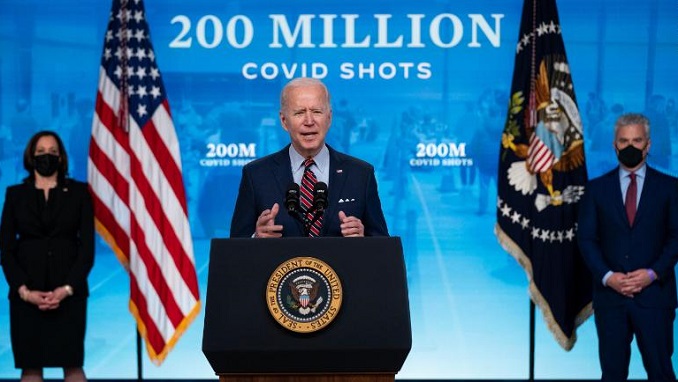
President Joe Biden on Thursday will kick off a climate summit attended by 40 other world leaders by announcing an ambitious cut in greenhouse gas emissions as he looks to put the US back at the center of the global effort to address the climate crisis and curb carbon emissions, CNN learns.
At the White House summit, which will take place virtually on Thursday and Friday, Biden will commit the United States to reducing its greenhouse gas emissions by 50%-52% below its 2005 emissions levels by 2030.
The figures were struck after lengthy consultations with government agencies, scientists, industry representatives, governors, mayors and environmental researchers.
The move underscores the President’s commitment to addressing the climate crisis and follows on his pledge to work with other countries to find joint solutions to global issues.
What the President will not unveil, at least right now, is a specific road map for how the United States will reach those targets, which are being described as “economy-wide.” Officials described “multiple pathways” for the US to arrive at the goal, and said the President’s climate task force would release sector-by-sector recommendations later this year on achieving the necessary cuts.
“Achieving that target is something we can do in multiple ways. In the coming months you will continue to see from the administration a focus on driving forward the necessary actions that unlock the jobs opportunity that tacking the climate crisis presents,” a senior administration official said a day ahead of the announcement.
Several members in Biden’s Cabinet will play a role at the summit, including hosting sessions, speaking at sessions and discussing how their role or department or agency pertains to issues surrounding the climate crisis, a separate administration official said earlier this week.
The summit will focus on mobilizing public and private sector finance to reach net-zero emissions and “build a resilient future,” according to the official. The US plans to discuss investing in innovation, which the administration argues is critical to creating transformational technologies to reduce emissions and at the same time creates new economic opportunities.
It’s hoped that other countries will follow the US’ lead with additional announcements of new goals to tackle the crisis, the administration official said.
Russian President Vladimir Putin and Chinese President Xi Jinping are two notable leaders who have both confirmed their attendance at the summit, underscoring the wide range of leaders attending. The summit will also be attended by many allies of the US, including Canadian Prime Minister Justin Trudeau, French President Emmanuel Macron and British Prime Minister Boris Johnson.
The summit is a stark departure from how climate was approached for the past four years under former President Donald Trump. The former President repeatedly denied the scientific reality of the climate crisis and his administration systematically rolled back environmental policies.
Trump withdrew from the Paris agreement, but Biden administration officials said work on reducing carbon emissions proceeded anyway at the state and local level, which prevented the US from losing too much ground.
Since taking office in January, Biden has elevated climate change as an essential element of US foreign policy and national security. The US reentered the Paris climate accord, the landmark international agreement signed in 2015 to limit global warming, which Trump pulled the US out of.
Biden appointed former Secretary of State John Kerry as his special presidential envoy for climate, a Cabinet-level position that sits on the National Security Council. The President also named Gina McCarthy, a former head of the Environmental Protection Agency, as his White House climate czar to lead his newly formed Office of Domestic Climate Policy.
Climate is a big focus of the President’s roughly $2 trillion infrastructure proposal. He has said his proposal would create hundreds of thousands of jobs while tackling the climate crisis, reducing emissions and building a “modern, resilient and fully clean grid.”
Officials said they conducted a “techno-economic” analysis across various sectors — including electricity, transportation, buildings, industry, lands and oceans — to identify various pathways for reducing emissions in each one. That included the potential for new standards and incentives that would limit greenhouse gasses.
“The 2030 target is a target we believe we can meet,” the senior administration official said.
As a presidential candidate, Biden put forward a plan to end carbon emissions from power plants by 2035 and proposed broader public investment in green infrastructure, including $2 trillion for clean energy projects.

Be the first to comment